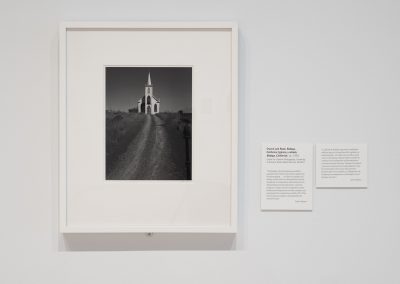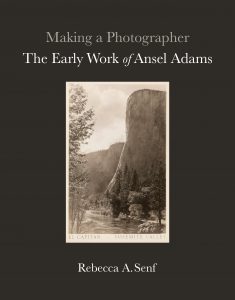Photo Credits for all images provided for this article:
Installation view, Ansel Adams: Performing the Print, 2020, Phoenix Art Museum. Image courtesy of Phoenix Art Museum. © The Ansel Adams Publishing Rights Trust.
Back in 2012, I led a weekend connoisseurship workshop at the Center for Creative Photography for members of INFOCUS, Phoenix Art Museum’s photography support organization at the time. The premise of the workshop was that the best way to learn about photographs was to see LOTS of them, and to compare and contrast, to discern qualities otherwise hard to distinguish and define. Over the course of the weekend, many suites of prints were presented, each with a particular point. One group showed the range of subtle colors within gelatin silver prints (the most basic type of black-and-white photograph); another showed how Ansel Adams’ prints changed over the span of his nearly seven-decade career; another showed the difference between platinum prints and gelatin silver prints; while another showed various types of damage and condition issues that photographs can suffer. It was great fun and an intensive way to learn about photographs in a concentrated period of time.
This notion of learning through contrast and by seeing difference for oneself, informs my current exhibition at the Phoenix Art Museum: Ansel Adams: Performing the Print, which is on view in the Norton Photography Gallery through June 6, 2021. Those of us who have made gelatin silver prints in a darkroom appreciate the many nuanced steps required to make a finished print. But for some, whose only experience with photographic prints is picking up snapshots at the drug store, or even hitting Control-P to make a quick print from a digital file, the darkroom process can be opaque and mysterious. So, who better to “explain” the process than the technical master of gelatin silver printing, Ansel Adams, himself?
Ansel Adams famously said that the negative is like the composer’s score and the print is like the performance. He felt that each time he entered the darkroom to make a print, it was his prerogative to interpret it the way he felt on that particular day. Since gelatin silver prints are hand-made objects, it is difficult to make two prints exactly the same, and if fact Adams didn’t strive to make them all the same. He explored what variant cropping, or enlarging, or altering the printing process did to the impact, mood, and sense of a final print.
At the Center for Creative Photography, within the Ansel Adams Archive, we have a breadth of his work that is unparalleled anywhere else in the world. We have various prints of many of his most famous images and as well as multiple prints of many of his lesser-known pictures. Seeing more than one version of an image — like Arches, North Court, Mission San Xavier Del Bac, Tucson, Arizona, 1968, in which the dodging and burning have created subtle differences in the darkness of the shadow areas relative to the print’s highlights — can help people appreciate what it means to interpret a negative through the printing process. That’s precisely what we have done with this exhibition. Most of the sixty works in the show are presented as pairs or sets of three prints, to allow visitors to compare and contrast. Each comes with a label that explains what to look for. In some cases, the differences are subtle, as with a group of three, similarly-sized Aspens, Northern New Mexico, 1958 prints in which the foliage has been dodged and burned differently to create slightly lighter and darker passages. In other cases, clear changes in cropping shift the focus of an image. In one of my favorite examples, we present two variant prints of Adams’s Boards and Thistles of 1932 — one as an 8×10 inch contact print, in which the negative was laid atop the photosensitive paper to make an exact-sized print, and another as an enlargement. The related label includes a quote from Adams’s 1984 book Examples: The Making of 40 Photographs in which he states that this picture is one he feels works both as a contact print and in larger sizes. It’s a wonderful opportunity to get up close and examine the difference between a contact print and the same image as an enlargement.
When I plan exhibitions, I have several goals in mind. One is that the exhibition needs to show . . . to visually illustrate the thesis, and that the supporting text is just that, a support to the impact of the visual experience. Another goal is that the exhibition be fruitful to visitors with a range of background experience. I literally imagine different profiles of museum-goers in order to determine if I’m hitting lots of access points. So, for instance, I think about my neighbor, who doesn’t know anything about photography, but is generally an engaged and curious person: will the exhibition be clear and inviting to her? What about those people who know about photography and engage with the medium in a deeper way (for years, the person I used as my example in this category was Richard Nilsen, the arts reporter for the Arizona Republic, who was also a photographer himself). And then finally, what about a specialist? Could someone who knows a lot still find something new, something to learn, something they haven’t seen before? Here I imagine trying to create a show that will engage Mark Klett.
Another goal is to create exhibitions that reveal the distinctive qualities of the collection of the Center for Creative Photography. I strive to produce exhibitions that exploit the unique aspects of the CCP — whether that’s our archival holdings of manuscripts, correspondence, and working materials; the great depth of work by photographers like W. Eugene Smith or Sonya Noskowiak; the incredible range of photographs (like those we showed in One of a Kind: Unique Photographic Objects from the CCP back in 2015); or particular strengths (like platinum or aerial photography). All of these goals inform our planning process, and I feel that Ansel Adams: Performing the Print is such a great fulfillment of these various aims.
The exhibition comes at a funny time in our collective history. Opened in January 2020, it was available to the public for just a few months before the museum closed; thankfully it’s back open for visitors now. We have extended the closing date to early in June to allow ample time for people to view this unique opportunity to compare Ansel Adams prints, side-by-side, and with guidance from an Adams scholar about what to look for. I hope that you’ll enjoy the exhibition and that you, too, will see something new and inspiring.
If you go, drop me a note via email or social media and let me know what you thought!

Dr. Rebecca Senf
Chief Curator, Center for Creative Photography, University of Arizona
Dr. Rebecca Senf is Chief Curator at the Center for Creative Photography at the University of Arizona, in Tucson. Her B.A. in Art History is from the University of Arizona; her M.A. and Ph.D. were awarded by Boston University. In 2012, her book Reconstructing the View: The Grand Canyon Photographs of Mark Klett and Byron Wolfe was released by University of California Press; in 2017, her book To Be Thirteen, showcasing the work of Betsy Schneider, was published by Radius Press and Phoenix Art Museum. Senf is an Ansel Adams scholar, and recently published a book on Ansel Adams’s early years, called Making a Photographer, copublished by the CCP and Yale University Press.
Contact Rebecca
Send a Note
Instagram: @beckysenfccp
Facebook: Becky Senf Ccp
Website






